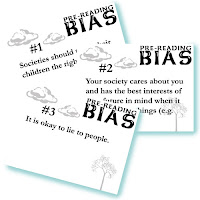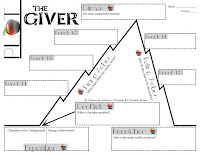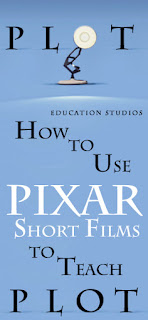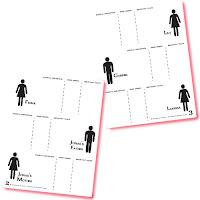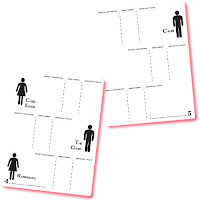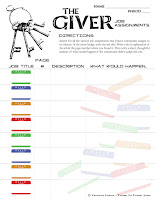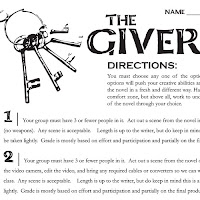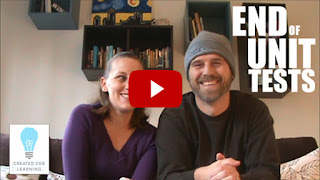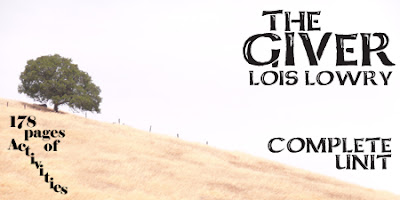Last school year, thousands of teachers across the country enjoyed teaching our novel units. Today, we’re going to show you a sample of the kinds of engaging activities you’ll find inside one. This way, if you’ve been trying to decide if our novel resources are right for your style and classroom, you’ll hear our thoughts behind how they work. So let’s take a look at our novel unit for THE GIVER by Lois Lowry.
Watch the YouTube video here >>> https://youtu.be/2P9Knh-EphM
I taught novels and short stories for many years, reading, doing worksheets, closed-ended discussion, and more reading. Then I started noticing that I was doing most of the thinking and I needed to hand more of the thinking and learning over to my students and get them more engaged. Today, we want to walk you through a unit and talk about how to flip things for yourself the way we did.
 To start off, we challenge our students with nine controversial statements that are intentionally created to divide the students into two sides based on their biases. We go question by question and have students physically separate to different sides of the classroom. “If you agree, come to this side…If you disagree, come to this side. Try not to be a maybe or I don’t know.” Then we have students on both sides express their opinions, while we teachers offer challenging-yet-respectful questions back to each speaker. Students really practice their polite argument skills, while activating prior knowledge about the deeper issues and getting them emotionally connected to the story’s ideas before we even start reading.
To start off, we challenge our students with nine controversial statements that are intentionally created to divide the students into two sides based on their biases. We go question by question and have students physically separate to different sides of the classroom. “If you agree, come to this side…If you disagree, come to this side. Try not to be a maybe or I don’t know.” Then we have students on both sides express their opinions, while we teachers offer challenging-yet-respectful questions back to each speaker. Students really practice their polite argument skills, while activating prior knowledge about the deeper issues and getting them emotionally connected to the story’s ideas before we even start reading.
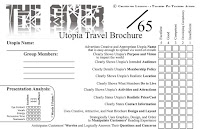
 To finish our intro, we discuss utopias vs dystopias. Our visually engaging PowerPoint introduces the difference between real life and utopias/dystopias. We look at examples of people who have set up real utopian colonies. There are some great videos on YouTube of these colonists talking about their ideals. Then the students break into groups and start a project where they design their own utopia that attempts to solve the world’s problems. They have a great time thinking philosophically about the world’s problems and coming up with solutions. They create their own society and design a travel brochure advertising their utopia. This can take up to a week. Then each group presents their utopia to the class, trying to convince us to join them. The class responds by asking tough questions about how the utopia works. When all presentations are done, these brochures will look great on your wall while reading the novel.
To finish our intro, we discuss utopias vs dystopias. Our visually engaging PowerPoint introduces the difference between real life and utopias/dystopias. We look at examples of people who have set up real utopian colonies. There are some great videos on YouTube of these colonists talking about their ideals. Then the students break into groups and start a project where they design their own utopia that attempts to solve the world’s problems. They have a great time thinking philosophically about the world’s problems and coming up with solutions. They create their own society and design a travel brochure advertising their utopia. This can take up to a week. Then each group presents their utopia to the class, trying to convince us to join them. The class responds by asking tough questions about how the utopia works. When all presentations are done, these brochures will look great on your wall while reading the novel.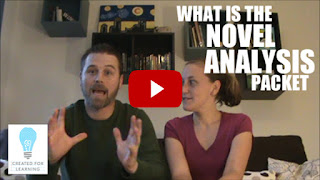
Our graphic organizers aren’t your typical printables. Our design turns the analysis responsibilities over to the students. During the whole journey reading the novel, they provide textual support instead of the teacher providing it. Students analyze while reading and during breaks between reading when they sometimes work alone and sometimes in groups.
With Plot, we teach them through the differences between the six parts of the plot arc. The students pay attention to the story and analyze when the events change in the story arc. (Get this FREE activity in our store > http://bit.ly/giverplot)
(If you need a good free resource to introduce or reinforce the plot concept, check out our Pixar plot charts and PowerPoints that have been downloaded by over 75,000 teachers! http://bit.ly/pixarplot)
With Conflict, we teach them the six different types: Humans versus other humans, nature, herself, supernatural, society, and technology. While reading, students look for examples of these conflicts. (Get this FREE activity in our store > http://bit.ly/giverconflicts)
With Characters, students analyze the physical descriptions, inner desires, and important traits of the characters.
We’ve written up deep and sometimes controversial Quickwrite writing prompts. Students write unedited off-the-cuff responses to various quotes, situations, issues that arise from within the story. The questions take them into memories from their lives (activating prior knowledge), connections with the story’s characters and history (encouraging empathetic reading and understanding), and deep areas of thematic meaning (spurring informal argumentation). These discussions often go really deep and usually prove to be some of the most meaningful explorations for our students.
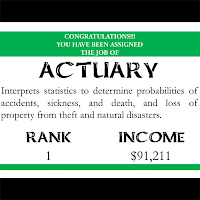
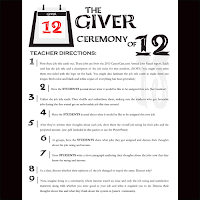 You know the Ceremony of Twelve that the character Jonas goes through? We’ve made the ceremony for you! Using data from the Top 200 Jobs from CareerCast.com, students will go through a simulation of the Ceremony of Twelve that Jonas undergoes. They are each assigned a “good job” and “bad job” then we discuss why some jobs rank higher for satisfaction, salary, and future job prospects. This activity is so interesting and fun for the students and really connects them to the characters’ situation.
You know the Ceremony of Twelve that the character Jonas goes through? We’ve made the ceremony for you! Using data from the Top 200 Jobs from CareerCast.com, students will go through a simulation of the Ceremony of Twelve that Jonas undergoes. They are each assigned a “good job” and “bad job” then we discuss why some jobs rank higher for satisfaction, salary, and future job prospects. This activity is so interesting and fun for the students and really connects them to the characters’ situation.
Students analyze the jobs required and assigned by Jonas’s community. We discuss which jobs are more or less necessary and if any should be given a place of higher honor in Jonas’s society or our society today?
We’ve all seen the matching or multiple choice vocabulary assessments with the words in one column and the dictionary definitions in the other. We’ve designed assessments that require the students to understand the context of the word in the right situation.
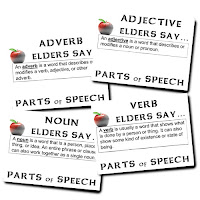
 We’ve included some of required grammar topics using examples from the story. This way you don’t have to completely stop the novel and move into a grammar unit … We’ve got verbals: infinitives, participles, gerunds. And we’ve got clauses and phrases: adjective, adverb, and noun. With these activities, the students still feel like they’re in the story’s world while they’re learning their grammar.
We’ve included some of required grammar topics using examples from the story. This way you don’t have to completely stop the novel and move into a grammar unit … We’ve got verbals: infinitives, participles, gerunds. And we’ve got clauses and phrases: adjective, adverb, and noun. With these activities, the students still feel like they’re in the story’s world while they’re learning their grammar.
We’ve crafted our Pop Quizzes to assess whether or not students read the chapters. If the students read the chapters, they should earn 100%s…if they didn’t read, they should not be able to guess their way to success. These can also be used as exit cards or quick comprehension assessments to see if you need to further explain the main events of the chapters.
If you choose to assign an essay, students choose from a few deep topics to either write an essay or turn their essay outline into a speech on the topic. During the speeches, students will need to understand and chart the speakers’ thesis statements. And for you . . . no-hassle grading rubrics are included to make your teaching life easier and save you time.
In lieu of essays or speeches, you might want to have your students choose a final project to create and present to the class. A wide variety of project options are provided to meet students’ preferences, artistic skills, technology access and talents, and create diversity in the final products and presentations. It also allows students the ability to work alone or in groups. The students find these project ideas as engaging as they are challenging.
For our final discussion, we’re going to provide enough time and emotional space for an unforgettable thematic experience for our students.
The day before this activity, we prepare our students by telling them to start thinking about a seriously large pain in their recent or current life. It can be any kind of pain: physical, emotional, relational, familial, social, spiritual, etc. On discussion day, start by having each student draw an anonymous picture or illustration of their recent pain.
Start displaying the pictures one at a time, giving moments of respect for each pain – magnets or clips work great on the whiteboard. As they get displayed, start sorting them into pain categories (death, love, depression, physical, friends, etc.) FAIR WARNING: Some of the pains might be eye-opening and intense.
After they’re all displayed, discuss how Jonas’s world “fixed” all these pains and what lengths our world would have to go to to fix these pains. Wait for them to realize they’d have to give up choice. And like Jonas, they love being able to choose things. At the end, don’t let them leave your class completely sad and depressed. Finish with some words about how to take all these pains and go live and feel what it means to be human. They should be feeling a fuller reality and truth about life now that they realize pain is a necessary part of the full, shared human experience.

 After we’ve finished reading everything and had our final discussion, we read Lois Lowry’s Newbery Award Acceptance Speech and analyze the deeper thematic meanings that she mentions and explains the background of. We’ve recorded the audio version of the speech for you to play while students read along.
After we’ve finished reading everything and had our final discussion, we read Lois Lowry’s Newbery Award Acceptance Speech and analyze the deeper thematic meanings that she mentions and explains the background of. We’ve recorded the audio version of the speech for you to play while students read along.
We’ve included a helpful organizer for students to compare and contrast the movie. This keeps them engaged and thinking critically while enjoying the artistic film interpretation of the story.
And want to finish things off with a little competitive frivolity?! We’ve created a fun trivia competition that students always love. Let the students do it alone or in teams.
Some of you might be noticing that there is no end of novel comprehension test. Yes, we do not have end of novel comprehension tests. Find out why here > https://youtu.be/ZtyCeJQVkxE
We hope this gives you a full picture of how we’ve flipped things around to really get students thinking. Our students are always sucked into these activities and challenged by the level of rigor in the thinking, writing, and discussing. And every year at the end of this, our favorite part is how much our students have thought about much of the pain and hope of our human experience. So deep and memorable.
You can get this teaching unit here >>> http://bit.ly/giverblog
Conversation of the Day: How does one of these activities inspire you to get students engaged and thinking about studying a novel?
Hop on over to watch the video and share your thoughts in the conversation.

